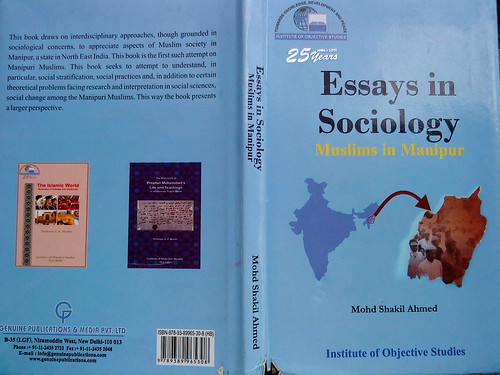By Dr. Syed Ahmed, for TwoCircles.net,
A book, titled Essays in Sociology: Muslims in Manipur, written by a Ph.D. scholar Dr. Mohd Shakil Ahmed was recently published by the Institute of Objective Studies, based at Jamia Nagar, New Delhi. The book deals with the social set-up and the socio-cultural life of the Muslim community in Manipur. The book has chapters on social stratification and community formation, social practices and social change of the Manipuri Muslims (locally known as Pangal).
Shakil traces the development of the social stratification system of the Manipuri Muslims called sagei, a social set-up almost similar to that of the Meities, the major community and the immediate neighbour of the Muslims.

A book on the Manipuri Muslim society released
The author writes about the development of sagei thus: “After the settlement of Muslims in Manipur in 1606 Muslim individuals or groups of individual Muslims were sought to be identified on the basis of individual skills or place of origin or the name of places where they settled, etc. The descendants of those individuals or groups of individuals came to be known by that identification. This identification is known as sagei (or yumnak) in Manipuri.” The sagei, according to Shakil, denotes kin/relative/genus.
The author explains that the sagei-based social arrangement did not make the Muslim society segmented: “Neither the sageis were arranged in a hierarchal order nor was there any restriction on social intercourse and commensality. However, there were restrictions on marriage. As a rule a Pangal sagei was exogamous, though exceptions occurred, which were frowned upon.”
Shakil observes that since the early 1930s Muslim society saw an attempt to see them in “ashraf” categories: “The 20th century, since the early 1930s to be precise, Pangal society saw an attempt to see them in ‘ashraf’ categories. Pangal sagei were sought to be classified into these categories. There were indeed Syed, Sheikh and Khan elements among the Manipuri Muslims in the 17th century, but the historical shaping of the Muslim community has not been on this grading. However, this framework was largely adopted by most of the Muslim writers, picked up since the early part of the 1970s. Thus the 20th century Muslim society in Manipur witnessed an attempt at ashrafisation.” Shakil explains that the process of ashrafisation could not make much progress as the established Muslim social set-up has been in terms of horizontal-spread of sagei. The author also writes about the other social arrangements of the Manipuri Muslims like leikai, singlup or mohalla.
Shakil devotes a chapter on the social practices of the Manipuri Muslims, particularly practices associated with birth, circumcision, marriage, festivities and death. The author also studied the marriage system of the Muslims in detail appreciating the cultural traits which the Muslims have adopted from the Meities. The author writes: “Marriage among the Pangals – as is the case among Muslims elsewhere – is contract. Nikah is performed in the same fashion. However, steps leading to marriage/nikah manifest their own peculiarities. There are two processes, which lead to marriage/nikah. They are: a) process of thiba chungba (process of seeking a wife) b) Chenba (elopement). The thiba changba is a very detail process following series of steps before the ultimate event of marriage or nikah takes place.” The author also writes about the walimah, a form of marriage where the nikah takes place at a mosque. He also notes the changes taken place over the years in the marriage customs of the Manipuri Muslims.
In the chapter on social change the author studies the process of Islamization that had started among the Manipuri Muslims from the first decade of the 20th century. The process commenced when Manipuri Muslims started going for education in the theological seminaries outside the state. Shakil notes: “Maulana Ibadullah, Maulana Kiramat Ali and Maulana Abdul Jalil are reported to be the earliest persons who went outside Manipur to study maulvi courses during the period of King Chadrakriti (1850-1886) and King Surchandra (1886-1890)….and the first haji among the Pangals was Amuraba during the reign of King Gambhir Singh (1825-1834) and (followed by) Barkatullah during the reign of King Chandrakriti…. With the emergence of Ulema, publications aimed at inculcating values grounded in Islam began to be published. The earliest (is) Punshiratki Pambei written by Amanullah in Manipuri and printed in Jorhat in 1938. In a series of Muslim books that began to appear since the late 1930s, the ones based on various aspects of Islam formed a significant portion. There was an LP Madrassa at Lilong in 1907-08… Madrassa Mazhar-uloom was established in 1920 at Mayang Imphal Bangoon. A relatively larger madrassa in Manipur was established in 1944 at Lilong…. In Manipur Tablighi Jamat started in 1978…And in 1980, with the establishment of state’s largest madrassa, Darul Uloom Madrassa at Lilong, the Markaz for Tabligh was established there….in 1961 Jamiat-ul-Ulema, Manipur was established in the state….”

The author of the book, Dr. Mohd Shakil Ahmed, in the middle (front row)
Renowned Sociologist, Imtiyaz Ahmad, who has written the foreword for the book writes that the Muslim communities spread in different parts of the country “should be studied in the context of the region in which they are located and an attempt should be made to study how their regional geography, ecology and history had shaped their present socio-cultural life.” He further writes: “This is precisely the task Dr. Mohd Shakil Ahmed has tried to accomplish in this book. He has chosen to write about Muslims in the context of the regional society of which they have been a part since their emergence on the social scene of Manipur.”
The author of the book, Mohd Shakil Ahmed, a resident of Lilong, in Thoubal district of Manipur, studied at Aligarh Muslim University and Manipur University. He has written articles on the social aspects of the Manipuri Muslims in many of the reputed research journals such as Economic & Political Weekly, American Journal of Islamic Social Sciences, Man and Society, etc.
